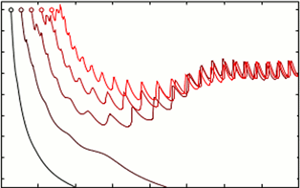Article contents
Asymptotic analysis of the critical dynamics of spherical gaseous detonations
Published online by Cambridge University Press: 29 March 2021
Abstract

The critical dynamics of supersonic combustion waves is studied in the context of the direct initiation of detonation in a spherical geometry. The study is performed by an asymptotic analysis in the limit of small heat release, including unsteadiness, curvature and the gradient of the burnt-gas flow. Derivation of analytical expressions for the rarefaction wave in the burnt-gas flow, combined with numerical studies, provides the basis of the analysis. The critical trajectories ‘detonation velocity vs front radius’  $\mathcal {D}(r_f)$ are characterized by a decay well below the Chapman–Jouguet (CJ) velocity at a small radius (however, larger than the detonation thickness), followed by a re-acceleration process back to a CJ detonation. The phenomenon is explained by the dynamics of the sonic point inside the inert rarefaction wave behind the reaction zone. The key mechanism is a critical slowdown as soon as the sonic condition (relative to the lead shock) approaches the reaction zone from behind, leading to an increase of the time delay in the nonlinear response of the combustion wave to the rarefaction-wave-induced decay. Detonation fails if the rate of decay is strong enough to prevent the sonic point catching the reaction zone. Concerning successful initiation, the link between the trajectories
$\mathcal {D}(r_f)$ are characterized by a decay well below the Chapman–Jouguet (CJ) velocity at a small radius (however, larger than the detonation thickness), followed by a re-acceleration process back to a CJ detonation. The phenomenon is explained by the dynamics of the sonic point inside the inert rarefaction wave behind the reaction zone. The key mechanism is a critical slowdown as soon as the sonic condition (relative to the lead shock) approaches the reaction zone from behind, leading to an increase of the time delay in the nonlinear response of the combustion wave to the rarefaction-wave-induced decay. Detonation fails if the rate of decay is strong enough to prevent the sonic point catching the reaction zone. Concerning successful initiation, the link between the trajectories  $\mathcal {D}(r_f)$ of the fully unsteady problem and of the self-similar CJ solution of the discontinuous model is deciphered in the long-time limit.
$\mathcal {D}(r_f)$ of the fully unsteady problem and of the self-similar CJ solution of the discontinuous model is deciphered in the long-time limit.
- Type
- JFM Papers
- Information
- Copyright
- © The Author(s), 2021. Published by Cambridge University Press
References
REFERENCES
- 2
- Cited by



